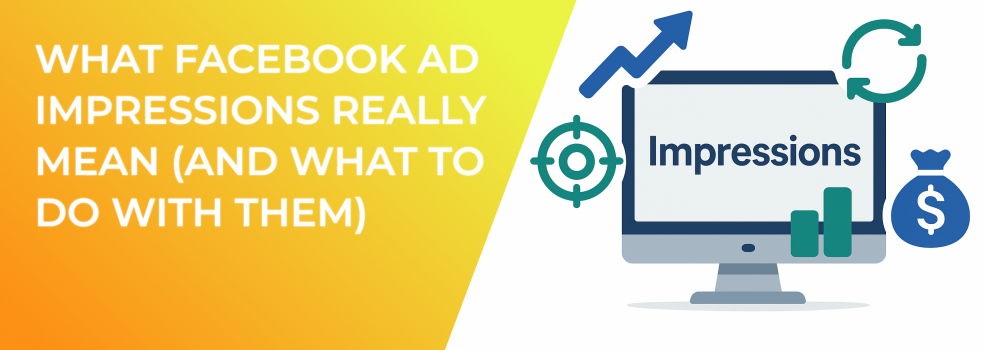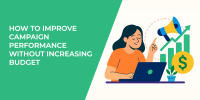Understanding impressions is the shortest route from “numbers on a screen” to profit in your bank account. Every other metric inside Ads Manager — reach, frequency, CTR, CPM, CPC, even conversion rate — starts with that single moment when your creative loads on a user’s device. Below you will find not only a definition of Facebook ad impressions but also an expanded playbook for squeezing maximum value out of every view.
1. Impressions in Plain English
A Facebook ad impression is recorded each time your ad is displayed, no matter whether the person scrolls past, reads the headline, or taps the CTA. One individual can rack up dozens of impressions if the same creative set appears in multiple placements (Feed, Reels, Stories, Right Column) or over multiple days. That fact alone is why impressions behave so differently from reach, which counts unique people, and frequency, which calculates the average repeats per person.
How Impressions relate to Reach (unique people) and Frequency (average repeats).
Why does Meta treat impressions as the atomic unit of its auction? Because their ad server sells real-time inventory measured in milliseconds. If your ad wins the auction for a specific slot, an impression is logged before anything else. This also explains why ads can burn budget quickly inside small retargeting pools: the algorithm keeps redisplaying the same units to the same people until those users convert or hit your frequency cap.
A quick numbers illustration helps ground this concept:
-
10,000 impressions
-
4,000 reach
-
2.5 frequency
Here you paid for 10,000 “looks” but actually touched only 4,000 individuals. If your CTR Facebook benchmark is 1%, those 10,000 impressions would generate about 100 clicks. Raising reach expands market coverage, while trimming frequency reduces redundancy. Learn to juggle these three levers and you can influence nearly every cost metric that follows.
2. Why Impressions Drive Every Performance Metric
Click-Through Rate (CTR). An ad that garners an average click through rate on Facebook ads of 1.4 % during the first 48 hours often slides below 0.8% by day seven as saturation and creative fatigue creep in. Because CTR is calculated as clicks ÷ impressions, bloated impression counts with no uptick in clicks will pull CTR down and tell the algorithm your content is losing relevance.
Cost per 1,000 Impressions (CPM). Facebook advertising CPM is a direct reflection of auction pressure and creative quality ranking. When your ad stops engaging fresh eyeballs, your expected engagement score falls, which raises CPM. Over time this inflation flows downstream into average cost per click Facebook and ultimately CPA.
Cost per Click (CPC) and Cost per Conversion. Because CPC equals CPM × (1 / 1,000) × (1 / CTR), you can see the math: if impressions get expensive (higher CPM) or low quality (lower CTR), CPC increases. That is why pure Facebook ad optimization often starts at the top of funnel with impression efficiency rather than at the bottom with bid strategies.
Conversion Rate and Return on Ad Spend (ROAS). No impression, no conversion—full stop. Even a perfectly-tuned offer page cannot salvage a campaign if the bulk of impressions are hitting people outside your buyer persona. Quality impressions prime the auction to favor you, lift relevance diagnostics, and unlock higher-ranking inventory at a discount.
3. Diagnosing Impression Problems Like a Pro
The first step in every Facebook advertising analytics audit is to split performance by day, placement, and audience. Doing so surfaces patterns hidden in blended numbers.
Low impressions plus low reach usually points to an audience that is too small or a bid cap that is too restrictive. Another culprit is the learning limited Facebook ads status. Meta’s system needs roughly 50 conversion events per ad set in a seven-day window to fully exit the learning phase. If you never reach that threshold, Meta’s delivery throttles impressions to avoid overshooting your bid.
High impressions with rising CPM and falling CTR screams creative fatigue. Images that wowed in week one become wallpaper by week three. Watch the Facebook ad CTR average inside each ad set: when it slips below your historic baseline and CPM climbs, rotate in fresh hooks, adjust background colors, change the opening three seconds of video, or update your primary text.
High impressions and frequency above 3 with steady CTR often indicates that your budget is simply outspending a narrow audience. Instead of dialing daily spend down manually, activate advantage campaign budget or full-funnel campaign budget optimization. Meta’s smart algorithm will redirect unused budget toward ad sets capable of finding net-new eyeballs at target cost.
High frequency inside a tiny audience wastes budget on redundant impressions.
Pro tip: After each creative cycle, check click rate Facebook ads by placement. If right-column or in-stream video placements drive cheap impressions but near-zero clicks, exclude them. Paying for empty impressions drags every metric south.
4. Turning Impressions Into Results: Six Proven Plays
1. Refresh Creatives Every 7–14 Days
Human attention is fickle, and the Meta feed is infinite. Swapping in new imagery, punchier headlines, or different aspect ratios keeps best Facebook ad practices alive and prevents ad blindness. Dynamic Creative can automate asset mixing so you discover which combination sustains an above-average Facebook ad ctr what is good for your niche.
2. Segment by Placement and Device
Feed on mobile and Feed on desktop present two different canvases. A carousel that shines on mobile may perform poorly on desktop where large monitors exaggerate white space. By duplicating the ad set and locking placements, you gain granular control over where your impressions appear and can push budget toward the more profitable channel.
3. Embrace Campaign Budget Optimization (CBO)
Traditional ad sets can hog spend, starving promising newcomers. CBO listens continuously to CPM, CTR, and conversion probabilities, flowing extra budget toward the ad set with the cheapest qualified impressions. Many media buyers see a 10–15 % CPM reduction after switching mature accounts to CBO.
CBO automatically shifts budget to the ad set generating the cheapest qualified impressions.
4. Cap Frequency Strategically in Retargeting
Impressions inside a warm audience behave differently. You want at least three exposures to unlock familiarity but rarely more than seven within 14 days unless you are running a time-sensitive promo. Excessive retargeting impressions annoy users, hike negative feedback, and penalize your ad rank.
5. Automate Creative Testing at Scale
Split-testing still images versus short-form video, bold backgrounds versus muted palettes, or first-person ad copy versus third-person social proof helps you discover what drives a higher CTR Facebook not just once but repeatedly as the market evolves. Modern workflows pair Dynamic Creative with software that auto-pauses low performers after a statistically significant threshold—saving you manual labor.
6. Build High-Intent Audiences With Precision Targeting
A pixel that fires on valuable behaviors feeds Meta’s lookalike engine richer signals. If you use WordPress or Shopify, installing the base pixel is easy, but create separate events for key funnel milestones as well. Various tools can layer CRM data, FB retargeting segments, and zero-party signals so your impressions reach buyers, not browsers, which accelerates conversions and lets you raise daily spend without spiking CPM.
5. From Theory to Weekly Execution
Start each Monday by opening Ads Manager and filtering the last seven days. Compare CPM, CTR, and Frequency against the prior week. If CPM has crept upward while CTR remains flat or down, your impressions are becoming less efficient. Move straight to the Breakdown tab and scan for placements or age brackets where CPM inflation is heaviest. Pause or reduce bids in those weak pockets so that budget shifts automatically toward stronger segments.
Mid-week, dedicate an hour to asset creation. Outline two new hooks that speak to different pain points uncovered in your comments or support tickets. Turn those hooks into one short-form video and one static image, then load them into an existing ad set using Dynamic Creative. Launch Thursday morning so the system can gather enough impressions before weekend traffic spikes.
On Friday, dive into audience diagnostics. Review overlap between lookalike stacks and interest groups. Meta’s inspector shows shared users; if overlap exceeds 30%, consolidate ad sets to reduce internal bidding wars that waste impressions. Also review cost of advertising Facebook by country. If a particular region generates bargain CPMs with acceptable purchase rates, earmark budget to test a locally flavored creative next week.
Throughout this flow, keep an eye on the learning limited Facebook ads label. If it appears repeatedly, your account is starving for conversion volume. Combine small audiences into larger ones, loosen geo-filters, or extend optimization windows so Meta has enough data to fully explore new impression pockets.
Final Thoughts
Impressions are the first point of contact, the metric that private tells you how many chances you are giving your creative to win minds and wallets. Optimize the quality and cost of those impressions and you unlock compound gains throughout the funnel: lower CPC, stronger conversion rates, healthier ROAS. If you want to supercharge this process, LeadEnforce specializes in building laser-targeted custom audiences and automating creative rotation so every impression lands on the right screen at the right moment. Start refining your impressions today, and tomorrow’s metrics will thank you.

